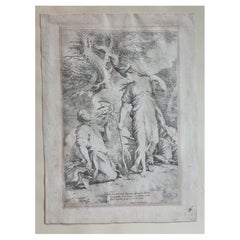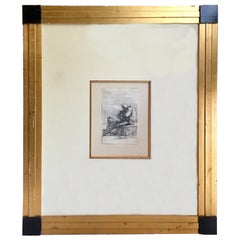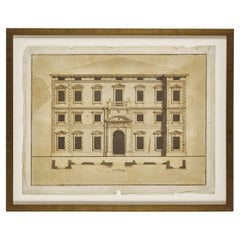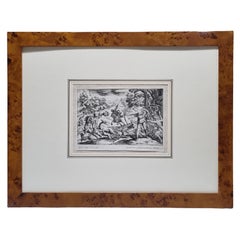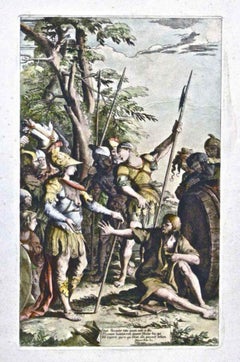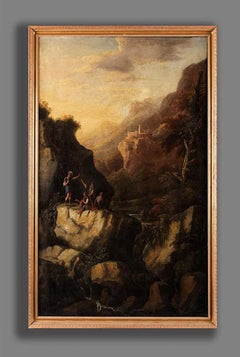Salvator Rosa
to
1
1
1
2
2
17th Century Etchingn and Drypoint" Ceres and Phytalus" by Salvator Rosa, 1662
By Salvator Rosa
Located in Cagliari, IT
" Ceres and Phytalus"
To left, Phytalus, kneeling, receives the fig tree from the goddess Ceres, standing to right, as a reward for his hospitality. Etching and drypoint, circa 1662...
Category
17th Century Italian Baroque Antique Salvator Rosa
Materials
Paper
Fine 17th Century Italian Etching by Salvator Rosa, 1615-1673
By Salvator Rosa
Located in Vero Beach, FL
Salvator Rosa, the Italian Baroque painter was also a significant etcher and printmaker. Rosa’s is series of small prints of soldiers was very popular and influential. This etching i...
Category
17th Century Italian Baroque Antique Salvator Rosa
Materials
Paper
Related Items
17th Century Pen and Ink Architectural Drawing Signed Bartolomeo Pedrelli
Located in New York, NY
17th Century Italian Architectural Drawing of a Palazzo which has been done with pen and ink with a grey wash. Signed on reverse by Bart...
Category
17th Century Italian Neoclassical Antique Salvator Rosa
Materials
Paper
H 24 in W 29.75 in D 1.5 in
17th Century "Diana's Deer and Boar Hunt" Etching by Antonio Tempesta
By Antonio Tempesta
Located in Cagliari, IT
A fine mythological etching by the great Italian engraver Antonio Tempesta (Florence, 1555 – Rome, 5 August 1630) printed by François L'Anglois or Langlois (12 May 1589 (baptised) – 13 January 1647),also called F. L. D. Ciartres (" Francois Langlois from Chartres"). Beautiful sheet , very sharp .
The dimensions below are inclusive of the frame, the print without the frame measures 27x19 cm
Antonio Tempesta, also called il Tempestino (1555 – 5 August 1630), was an Italian painter and engraver, whose art acted as a point of connection between Baroque Rome and the culture of Antwerp. Much of his work depicts major battles and historical figures.
He was born and trained in Florence and painted in a variety of styles, influenced to some degree by "Counter-Maniera" or Counter-Mannerism. He enrolled in the Florentine Accademia delle Arti del Disegno in 1576. He was a pupil of Santi di Tito, then of the Flemish painter Joannes Stradanus. He was part of the large team of artists working under Giorgio Vasari on the interior decoration of the Palazzo Vecchio in Florence.
His favourite subjects were battles, cavalcades, and processions. He relocated to Rome, where he associated with artists from the Habsburg Netherlands, which may have led to his facility with landscape painting.
Among his followers was Marzio di Colantonio.
Tempesta and the Flemish painter Matthijs Bril were commissioned by Pope Gregory XIII to paint wide panoramas of the Procession to Transfer the Relics of St. Gregory of Nazianzus (1572) for the loggias on the third floor of the Vatican Palace. He completed frescoes in the Palazzina Gambara at the Villa Lante in Bagnaia (1578-1609). From 1579–83, Tempesta participated in the decoration of the Villa Farnese in Caprarola, notably of this villa's Scala Regia. He is also known to have collaborated on frescoes in the Villa d'Este at Tivoli and the Palazzina Gamara at Villa Lante, Bagnaia. He painted a series of turbulent and crowded battle scenes for the Medici. He also completed a series of engravings on outdoor courtly hunting scenes.
Tempesta painted frescoes for the Palazzos Colonna, the Doria Pamphilj, and for the Marchese Giustiniani in his Roman palace, where Tempesta collaborated with Paul Bril, and at Bassano di Sutri. He painted a Massacre of the Innocents for the church of Santo Stefano Rotondo in Rome.
Tempesta is now best known as a printmaker in etching and engraving. He also left numerous etchings, among them: Plates from the Old Testament; twenty-four plates from the Life of St. Anthony; a set of 150 prints from Ovid’s Metamorphoses; 13 plates on The Labours of Hercules and four plates on respectively The ages of man; The entry of Alexander into Babylon; Diana and Actaon, and The crucifixion (1612).
In 1612 he engraved a series of plates under the title "Batavorum cum Romanis Bellum" after designs of the Netherlandish artist Otto van Veen, also known as Vaenius (1556-1629) and court painter to Alessandro Farnese. Van Veen was influenced by the Italian mannerists but had developed his own style anticipating the Flemish baroque of his pupil Peter Paul Rubens. The series consists of 36 numbered engraved plates and illustrates the armed struggle between the ancient Dutch tribes and their Roman oppressors as narrated in Tacitus' Histories. Each plate bears at the bottom an engraved legend in Flemish and in Latin while a detailed explanation is printed on the otherwise blank verso. Plate I, signed 'Ant.Tempesta f. Anno 1611', shows 'Roma' and 'Batavia' in battle dress with respective scenic backgrounds, symbolizing the two nations. Fifteen other plates bear Tempesta's monogram. The plates depict heroic events, sieges, and battle scenes. This historicist work was very popular in its time.
Tempesta also drew many designs for tapestries.
François L’Anglois or Langlois (12 May 1589 (baptised) – 13 January 1647), also called F. L. D. Ciartres ("François Langlois from Chartres"), was a French print publisher, print seller, engraver, bookseller, art dealer, and painter. He is widely considered to have been the first important print publisher in France and to have contributed significantly to spreading awareness of contemporary artists' work throughout Europe.
François L’Anglois was born in Chartres and baptised there on 12 May 1589. He visited Italy on several occasions: Rome in 1613 and 1614 and Genoa, Florence, and Rome again in 1621. On these trips he met Anthony van Dyck and Claude Vignon, who both painted his portrait. He also became acquainted with the engravers Stefano della Bella and François Collignon. It was probably around this time that he acquired the nickname of Chartres (Ciartres in Italian). In 1624–1625 he was associated with Vignon as an art dealer (paintings) and acted as a print collector for Thomas Howard, 14th Earl of Arundel, and Charles I of England...
Category
17th Century French Baroque Antique Salvator Rosa
Materials
Paper
Period Giltwood Italian Salvator Rosa Frame
Located in Roma, IT
Italian Salvator Rosa last 17th century giltwood frame.
Internal measurements cm 20 x 30
Pure example of Italian Salvator Rosa gild wood frame of 17th century.
"Salvator Rosa" is th...
Category
Late 17th Century Italian Baroque Antique Salvator Rosa
Materials
Wood
17th-Century Botanical Engravings of Mosses and Ferns By John Parkinson
By John Parkinson
Located in Downingtown, PA
John Parkinson was the last of the great English herbalists and one of the first of the great English botanists. Here the pair of prints show mosses and lichen and the other of ferns.
From: Paradisi in sole Paradisus Terrestris: or a garden of all sorts of pleasant flowers...
Category
1620s English Jacobean Antique Salvator Rosa
Materials
Paper
17th Century Pair of Etchings by Theodoor Van Thunlden from Rubens, Antwerp 1642
By Theodoor van Thulden, Peter Paul Rubens
Located in Cagliari, IT
"Arch dedicated to Hercules" and "Arch dedicated to Bellerophon"
Splendid and very rare etchings belonging to a suite of subjects executed for the preparations of the "Celebrations for the entry into Antwerp of the Cardinal-Infante Ferdinando of Habsburg-Spain on 17 April 1635".
The sketches for the decorations were all drawn by Sir Peter Paul Rubens and the execution of the etchings was entrusted to Van Thulden.
Bottom left: P.P. Rubens. Bottom right: G. Gervatius (who was commissioned to bring together the illustrations of the arches in a special volume) and Van Thulden.
Laid paper with watermark - copper imprint - margins - excellent condition.
At the end of 1634 Peter Paul Rubens (1577-1640) was invited to make a series of drawings to decorate the city of Antwerp on the occasion of the solemn entry of the infant cardinal Ferdinand of Habsburg (1609-1641) who, after his death of Archduchess Isabella Clara Eugenia (1633), Spanish governor of the southern Netherlands, had been elected as his successor. Generally in these circumstances, the itinerary was articulated through a series of stations and the city - in its main urban hubs - was adorned with decorations and ephemeral apparatuses which, without solution of continuity, covered the facades of the palaces, churches and convents facing the parade axis of the celebratory itinerary, testifying to the participatory role of the various public and private institutions that took part in the feast1. As had happened for the entrances of Charles V in 1520, of Philip II in 1549 and of the archdukes Albert and Isabella in 1599, also in this case, on 17 April 1635, the most important streets and squares of Antwerp were enriched with arrangements: temporary altars, four scenarios, a portico and large triumphal arches built in wood, over twenty meters height, decorated with paintings, sculptures and allegorical scenes. The references to the ancient alluded in this case to the greatness of the Habsburgs and to the merits of Ferdinand for the victory obtained over the Protestant armies of Sweden and their German allies. The choice to use the triumphal arch has its roots in the "city of the popes" and must be read as a connection with the triumphal and modern arches, with Rome and with the "possession" ceremony, placing the emphasis on its centuries-old use . In the elaboration of the drawings and sketches Rubens proved to be a true connoisseur of architecture, but what is most surprising about the artist is the casual use of architectural language and fidelity to sixteenth-century Roman models. In order for the memory of these works to be perpetuated over time, some artists were commissioned to etch the ephemeral apparatuses and, under the guidance of the painter Theodor van Thulden...
Category
17th Century Belgian Baroque Antique Salvator Rosa
Materials
Paper
H 33.47 in W 25.2 in D 1.97 in
Pl. 92 Antique Print of 17th Century Decorative Paintings by Racinet, circa 1890
Located in Langweer, NL
Antique print titled '17th Century - XVIIc Siècle - XVIILes Jahrhundert'. Chromolithograph of decorative paintings from the palace Fontainebleau ornaments. This print originates from...
Category
Late 19th Century Antique Salvator Rosa
Materials
Paper
H 16.34 in W 11.42 in D 0.2 in
17th Century Etchingn "Adoration of the Magi" by Pietro Testa, circa 1640
By Pietro Testa
Located in Cagliari, IT
Beautiful etching representing the classic religious subject of the "Adoration of the Magi" by the Baroque painter and engraver Pietro Testa known as il Lucchesino.
The print derives from an oil on canvas of the same name now in Montpelier.
Identified by the TPL monogram on the right and the dedication signature.
Paolo Bellini in the book "L'opera incisa di Pietro Testa" (The engraving work of Pietro Testa) ,published in 1976 by Neri Pozza in Vicenza, identifies this work as an example of the third state of three since, respect to the second state, the address of Gio Giacomo Rossi is added .
In the lower margin there is the dedication in Latin to:
Most illustrious and most reverend (cardinal) Gerolamo Bonvisi, Cleric of the Apostolic Chamber, D.D.
The star on the left often blushes with the light of evil / Kings live here so that they recognize the Lord, / happy face good star shines benignly./ Petrus Testa
Pietro Testa (1611–1650) was an Italian High Baroque artist active in Rome. He is best known as a printmaker and draftsman.
He was born in Lucca, and thus is sometimes called il Lucchesino. He moved to Rome early in life. One source states he was ejected from the Cortona studio in 1631, soon after joining the workshop. Others state Testa trained under Pietro Paolini or under Domenichino, for whom he worked under the patronage of Cassiano dal Pozzo. He was friends with Nicolas Poussin and Francesco Mola.
Some of his etchings, which often include work in drypoint, have a fantastic quality reminiscent of Jacques Callot, or embellishments of his Genoese contemporary Giovanni Benedetto Castiglione and even presciently suggest William Blake. His Sacrifice of Iphigenia appears to have influenced Tiepolo's rendition at Villa Valmarana Ai Nani in Vicenza. His early prints, from the 1630s, were often religious and were influenced by Federico Barocci...
Category
17th Century Italian Baroque Antique Salvator Rosa
Materials
Paper
H 14.06 in W 9.26 in D 0.04 in
Period Giltwood Italian Salvator Rosa Frame
Located in Roma, IT
Salvator Rosa last 17th century giltwood frame.
Internal measurements cm 32 x 41
Pure example of Italian Salvator Rosa gild wood frame of 17th century.
"Salvator Rosa" is the fa...
Category
Late 17th Century Italian Baroque Antique Salvator Rosa
Materials
Wood
Pl. 91 Antique Print of European 17th Century Jewelry by Racinet, circa 1880
Located in Langweer, NL
Antique print titled 'Europa XVIIth Cent - Europe XVIIe Siecle - Europa XVIItes Jahr'. Chromolithograph of European 17th century jewelry. This p...
Category
Late 19th Century Antique Salvator Rosa
Materials
Paper
H 8.67 in W 7.68 in D 0.02 in
Pl. 113 Antique Print of 17th Century French Tapestries by Racinet, circa 1890
Located in Langweer, NL
Antique print titled '17th Century - XVIIc Siècle - XVIILes Jahrhundert'. Chromolithograph of details from French tapestries ornaments. This print originates from 'l'Ornement Polychr...
Category
Late 19th Century Antique Salvator Rosa
Materials
Paper
H 16.34 in W 11.42 in D 0.2 in
Pl. 110 Antique Print of 17th Century Console Table by Racinet, circa 1890
Located in Langweer, NL
Antique print titled '17th Century - XVIIc Siècle - XVIILes Jahrhundert'. Chromolithograph of console table by Charles - Andre Boulle with metallic inlay ...
Category
Late 19th Century Antique Salvator Rosa
Materials
Paper
No Reserve
H 16.34 in W 11.42 in D 0.2 in
Pl. 102 Antique Print of French 17th Century Costumes by Racinet, circa 1880
Located in Langweer, NL
Antique print titled 'France XVIIth Cent - France XVIIe, Siecle - Frankreich XVIItes Jahr'. Chromolithograph of French 17th century costumes. Thi...
Category
Late 19th Century Antique Salvator Rosa
Materials
Paper
H 8.67 in W 7.68 in D 0.02 in
Previously Available Items
Saint Alexander - Original Etching by Salvator Rosa - Mid 17th Century
By Salvator Rosa
Located in Roma, IT
Saint Alexander is an original etching hand-watercolored, Image Dim: cm 44.5x27, Sheet Dim:cm 70x50
Interesting Artist's Proof, signed on plate lower into the cartouche with the ca...
Category
Mid-17th Century Old Masters Salvator Rosa
Materials
Etching
H 27.56 in W 19.69 in D 0.04 in
Mountainous landscape with a rugged rock with ancient build and figures
By Salvator Rosa
Located in Roma, IT
Mountainous landscape in the middle of which is a rugged rock with ancient buildings. Below, not far from the rock, is a small river, the water of which flows cascading over pieces o...
Category
17th Century Old Masters Salvator Rosa
Materials
Oil
H 64.97 in W 43.31 in D 1.58 in
Seated Soldier Framed
By Salvator Rosa
Located in Saint Augustine, FL
An original etching on laid paper by Italian artist Salvator Rosa (1615-1673) titled "Figure" c. 1730. Signed in the plate with the SR monogram. An 18th century edition of the print....
Category
Early 18th Century Baroque Salvator Rosa
Materials
Etching
Figure
By Salvator Rosa
Located in Saint Augustine, FL
An original etching on laid paper by Italian artist Salvator Rosa (1615-1673) titled "Figure" c. 1710. Signed in the plate with the SR monogram. An 18th century edition of the print....
Category
18th Century and Earlier Baroque Salvator Rosa
Materials
Etching
Figure
By Salvator Rosa
Located in Saint Augustine, FL
An original etching on laid paper by Italian artist Salvator Rosa (1615-1673) titled "Figure" c. 1710. Signed in the plate with the SR monogram. An 18th century edition of the print. Matted in 100% cotton rag matt from Holland; this work is frame ready. Image size: 5.5" x 3.75". Matted size: 14" x 12".
Salvator Rosa, (born June 20, 1615, Arenella, Sicily, Spanish Habsburg domain [now in Italy]—died March 15, 1673, Rome, Papal States [Italy]), Italian Baroque painter and etcher of the Neapolitan school remembered for his wildly romantic or “sublime” landscapes, marine paintings, and battle pictures. He was also an accomplished poet, satirist, actor, and musician.
Rosa studied painting in Naples, coming under the influence of the Spanish painter and engraver José de Ribera. Rosa went to Rome in 1635 to study, but he soon contracted malaria. He returned to Naples, where he painted numerous battle and marine pictures...
Category
18th Century and Earlier Baroque Salvator Rosa
Materials
Etching
Figure
By Salvator Rosa
Located in Saint Augustine, FL
An original etching on laid paper by Italian artist Salvator Rosa (1615-1673) titled "Figure" c. 1710. Signed in the plate with the SR monogram. An 18th century edition of the print....
Category
18th Century and Earlier Baroque Salvator Rosa
Materials
Etching
Salvator Rosa furniture for sale on 1stDibs.
Salvator Rosa furniture are available for sale on 1stDibs. These distinctive items are frequently made of paper and are designed with extraordinary care. There are many options to choose from in our collection of Salvator Rosa furniture, although beige editions of this piece are particularly popular. Many of the original furniture by Salvator Rosa were created in the Baroque style in italy during the 18th century and earlier. If you’re looking for additional options, many customers also consider furniture by and Matthäus Merian the Elder. Prices for Salvator Rosa furniture can differ depending upon size, time period and other attributes — on 1stDibs, these items begin at $630 and can go as high as $810, while a piece like these, on average, fetch $720.
